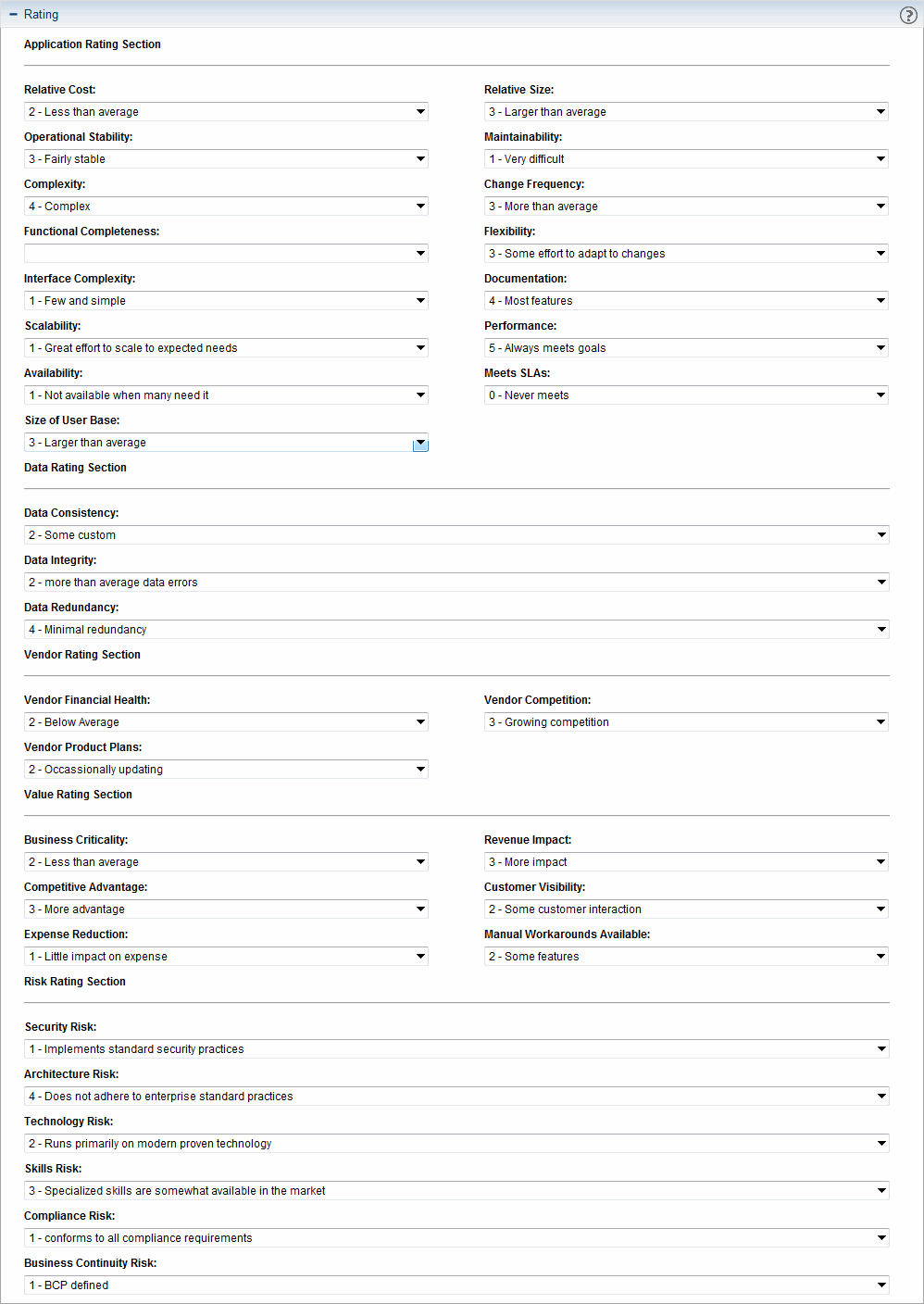Rating
In the Rating section, enter subjective measurements that reflect the business view of the application. These measurements are relative to the overall enterprise application portfolio.
Users assigned one or more of the following roles can view the data in this section: Business Owner, Technical Owner, Respondent (when more information is requested), or SME. Users assigned one or more of the following roles can edit the data in this section: Business Owner, Technical Owner, or Respondent (when more information is requested).
Figure A-8. Application Rating section

|
Field |
Description |
|---|---|
|
Relative Cost |
The total cost of the application compared to other applications in the portfolio (including licenses, underlying hardware costs, minor enhancements, and support).
|
|
Relative Size |
The size of the application compared to the size of the typical application in the portfolio.
|
|
Operational Stability |
The reliability and dependability of the application during required operational hours at required locations.
|
|
Maintainability |
The upkeep of the application compared to other applications in the portfolio.
|
|
Complexity |
The complicatedness and intricacy of the application compared to other applications in the portfolio. Complexity may be related to objective measurements such as the size of the application or the number of connections to other applications.
|
|
Change Frequency |
The number of times the system changes relative to the amount of change requests and incidents.
|
|
Functional Completeness |
The satisfaction of business requirements.
|
|
Flexibility |
The ability to modify the application when requirements change (for example, changes to standards, compliance, or regulations).
|
|
Interface Complexity |
The changes needed to integrate the application with other applications.
|
|
Documentation |
The completeness of the user documentation.
|
|
Scalability |
The ability of the application to support fluctuations in demand.
|
|
Performance |
The ability of the application to meet performance goals (for example, response time under maximum load or time to completion).
|
|
Availability |
User accessibility of the application during required operational hours.
|
|
Meets SLAs |
The ability to meet service level agreements or implicit expectations and needs.
|
|
Size of User Base |
The number of users compared to the number of applications in the enterprise.
|
|
Data Consistency |
The alignment of the application's data model with enterprise and industry standards.
|
|
Data Integrity |
The validity and consistency of data contained in the application. For example, are all dates entered in a mm/dd/yy format and does each date include all attributes?
|
|
Data Redundancy |
The profusion of the same data in multiple data sources distributed across the enterprise.
|
|
Vendor Financial Health |
The financial soundness of the vendor.
|
|
Vendor Competition |
The maturity of the competitive landscape and the availability of alternate vendors.
|
|
Vendor Product Plans |
The maturity of the application and if the enterprise affects the design process.
|
|
Business Criticality |
The importance of the application to the success and survivability of the business.
|
|
Revenue Impact |
The effect of the application, either directly or indirectly, on revenue.
|
|
Competitive Advantage |
The gain this application provides compared to other vendor's similar applications.
|
|
Customer Visibility |
The accessibility of the application to the customer.
|
|
Expense Reduction |
The decrease in costs when the application is used.
|
|
Manual Workarounds Available |
The availability of manual processes to accomplish the same business function.
|
|
Security Risk |
The liability of the application in regards to access and security.
|
|
Architecture Risk |
The liability of the application in regards to the architecture defined by the organization.
|
|
Technology Risk |
The liability of the application based on the technology it utilizes.
|
|
Skills Risk |
The liability of the application in regards to the availability of users with the ability to run the application.
|
|
Compliance Risk |
The liability of the application based on regulatory requirements and compliance validation.
|
|
Business Continuity Risk |
The liability of the application based on data backups and the availability of a business continuity plan (BCP). The liability may be affected by the criticality of the application to the enterprise.
|












